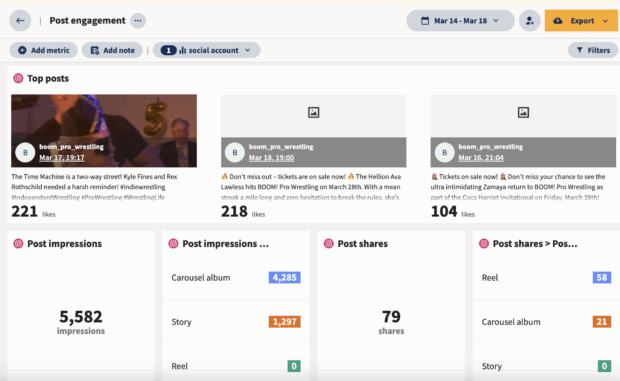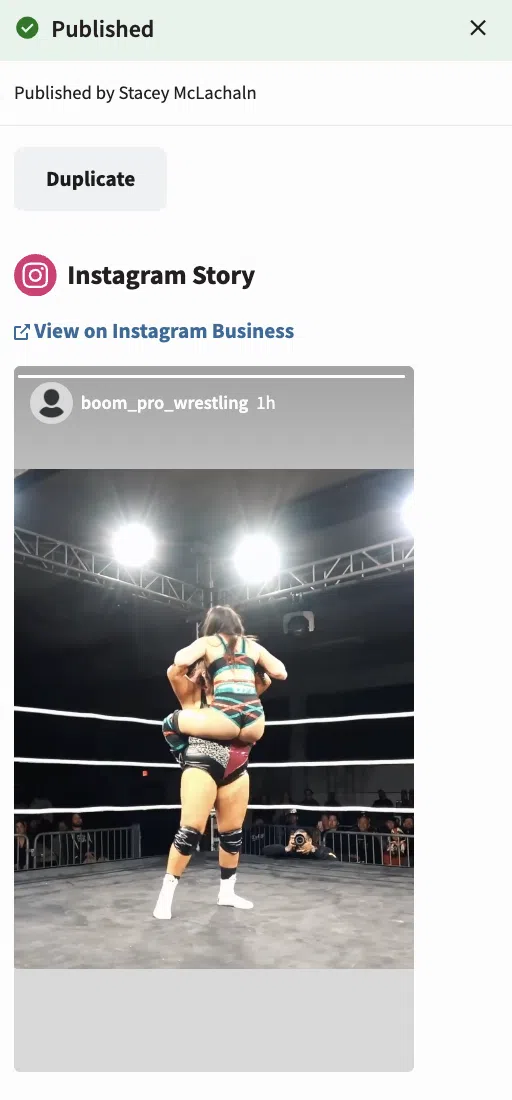and the distribution of digital products.
Experiment: Do third-party tools hurt Instagram performance?
For social media managers, it’s the ultimate urban legend, passed down through whispers and unverified Reddit posts: Using third-party scheduling tools can tank your social engagement. Is a chill running down your spine, or is it just me?
It’s easy to see how a rumor like this could spread. After spending hours perfecting your content calendar and scheduling everything through a tool like Hootsuite, when you notice a post underperforming, it’s only natural to wonder, “Is it my content, or the scheduling tool’s fault?”
But is this social media urban legend actually true, or is it just another conspiracy theory, like shadowbanning? Only one way to find out: it’s time to put this theory to the scientific test.
Does using third-party scheduling tools actually hurt your performance on platforms like Instagram? We’re about to find out.
Bonus!!!Use our free engagement rate calculator to find out your engagement rate 4 ways fast. Calculate it on a post-by-post basis or for an entire campaign — for any social network.
Download now Hypothesis Instagram posts scheduled through third-party tools will have lower reach and engagement than posts scheduled nativelyOkay, this isn’t necessarily our hypothesis, but it’s what the internet has claimed, unsubstantiated, for years. We’re big fans of the convenience of social media management tools like the Hootsuite dashboard, so the rumor has been rough to hear.
And look, maybe it’s not very scientific to admit, but we really hope it’s not true.
The theory goes like this: Instagram (and other social media platforms) can tell when you’re posting through a third-party app and will punish you for not using their native tools by limiting how many people see your content, essentially burying it in the algorithm.
If this theory is true, posts scheduled through external platforms should show lower reach, impressions, and engagement (likes, comments, shares, Story taps, saves, etc.) than those scheduled or posted manually within Instagram.
As a company that makes a scheduling tool, it would be easy to just dismiss this claim. But rather than ignore it outright, we decided to test it properly.
MethodologyTo test whether third-party social media scheduling tools affect performance, I needed to design an experiment that would isolate this variable while keeping everything else as consistent as possible. But as a sporadic personal poster, my own account wasn’t the best place to test this theory.
Instead, I asked my husband, the owner-operator of Vancouver’s Boom Pro Wrestling, if he would please let me use his business account (@boom_pro_wrestling) as a case study.
He kindly agreed. (Thanks, Max!)
View this post on InstagramA post shared by BOOM! PRO WRESTLING (@boom_pro_wrestling)
Of course, this experiment uses a wrestling business account, but we’d argue that the findings apply to any industry, from retail to nonprofits.
Here’s how I approached it:
Week 1: Posting and scheduling using InstagramMax posted five feed posts (a mix of single images, carousels, and Reels) and five Instagram Stories directly through Instagram.
View this post on InstagramA post shared by BOOM! PRO WRESTLING (@boom_pro_wrestling)
For example, a retail brand might post product photos, while a nonprofit could share impact stories — our wrestling content followed a similar promotional mix.
Max maintained his usual content mix (clips from shows, ticket sale announcements, wrestling photography), posting style, and hashtag strategy. After posting, he recorded engagement and reach metrics for each post.
We calculated the engagement rate for each post as the number of people who liked, commented on, or shared a photo, carousel, or Reel divided by the post’s reach (the number of people who saw it).
Week 2: Scheduling using HootsuiteFor the second week of the experiment, Max used a third-party tool (in this case, Hootsuite) to schedule five more feed posts and Stories.
The type of content was similar to what he’d posted the week before, with similar themes, caption lengths, hashtag counts, and identical posting times).

Of course, we recorded all performance metrics again. This was super easy to do thanks to Hootsuite’s built-in analytics features, as you’ll see — and Hootsuite calculates engagement the same way we did, which makes the comparison even cleaner.
To make the test as fair as possible, we:
- Used the same Instagram account for all posts
- Posted around the same time on corresponding days
- Kept caption lengths and hashtag counts consistent
- Used similar visual styles and content themes
Now for the moment of truth: did we see a significant difference between content posted natively versus content scheduled through Hootsuite?
Here’s what the data showed:
ENGAGEMENT RATETOTAL LIKESTOTAL COMMENTSTOTAL SHARESTOTAL REACH Native Posts6.44%336181097,189 Scheduled Posts8.19%713377910,122Larger tests are needed to confirm trends, but for now, it looks like we can put the rumors to rest. The numbers don’t lie: scheduled posts outperformed native posts in most metrics, including engagement rate.
The 1.75% increase in engagement rate for scheduled posts suggests a potential advantage, but with only five posts per method, this difference may not be statistically significant.
 What do the results mean?
What do the results mean?
Our small-scale experiment suggests that third-party scheduling tools like Hootsuite may not hurt Instagram performance and could even offer benefits.
Our experiment showed that in most cases, scheduled posts actually outperform native posts, suggesting that the Instagram algorithm doesn’t penalize content based on which publishing method you use.

Of course, this is an extremely limited sample size of data, and third-party scheduling tools may have a different impact on a different social media platform… but those are experiments for another day.
Results may differ across platforms, tools, or account types, so consider your unique context when choosing a scheduling method. And feel free to test it yourself to confirm!
For now, congratulations to all you social media managers who rely on scheduling tools to maintain your sanity. You can continue with your batch content creation and posting at the best time — keep on keepin’ on.
Why the scheduling method doesn’t matterInstagram’s algorithm is designed to show users content they’re likely to engage with based on their past behavior and preferences. The algorithm cares about factors like:
- The relationship between poster and viewer (how often they interact)
- The timeliness of the post
- The engagement the post has already received
- The type of content (image, video, Reel, etc.)
Thankfully, how the post was published appears to have no bearing on these factors. The platform is ultimately seeking to show relevant, engaging content to users, not punish people for using time-saving tools.

In fact, Instagram’s Graph API documentation shows that third-party tools can publish content smoothly, with no mention of algorithmic penalties for using these methods. Our experiment supports this, suggesting that the publishing method doesn’t affect algorithmic prioritization.
This likely applies to most third-party scheduling tools, such as Buffer or Later, though we only tested Hootsuite.
But why does the myth persist?If third-party tools don’t actually hurt performance (and, according to our study here, may actually help performance), why do so many people believe they do? A few possible explanations:
- Correlation vs. causation. Perhaps people who notice lower engagement after switching to a scheduling tool are experiencing other changes simultaneously (like shifts in content quality or posting frequency).
- Outdated information. It’s possible that in the early days of the Instagram API, there were limitations that affected how third-party posts performed. Those limitations (if they ever existed) appear to be long gone, but the myths live on.
- Confirmation bias. Once you believe something might hurt your engagement, you’re more likely to blame poor performance on that factor rather than considering other variables.
- The nature of social media algorithms. These algorithms change constantly, causing natural fluctuations in performance that people might wrongly attribute to their scheduling tools.
While our experiment showed that third-party scheduling tools don’t hurt post performance, there are some situations where your publishing method could potentially impact engagement on social:
- New features. When platforms release new features, they often limit access to their API partners initially. For example, when Instagram first launched Reels, you couldn’t post them via third-party tools. During these periods, using native posting for new features is necessary. (But you can schedule Reels on Hootsuite now, hooray!)
- Technical glitches. Occasionally, API changes can cause temporary issues with how third-party tools interact with social platforms. These are usually resolved quickly but might temporarily affect how your content appears.
- Platform-specific optimizations. Some native features (like Instagram’s “Add Yours” sticker for Stories) are only available when posting directly through the app.
Instead of worrying about whether scheduling tools are hurting your reach, focus on these factors that actually impact performance:
- Content quality. High-quality, relevant content that resonates with your audience will always perform better, regardless of how it’s posted. Here are 40 ideas for when you’re feeling tapped out for creativity.
- Audience understanding. Knowing what your followers want to see and when they’re online matters far more than your publishing tool. Here’s a guide to finding your target audience.
- Consistency. Regular posting keeps your audience engaged and signals to the algorithm that your account is active. Pssst: Scheduling your posts can help with that.
- Trend awareness: Staying on top of platform trends and embracing new features can give your content a boost. Time to get your social listening on!
- Engagement with your community: Responding to comments and messages signals to the algorithm that you’re fostering meaningful interactions. Take this webinar to level up your community engagement skills.
After concluding my official experiment, I can confidently say that using third-party scheduling tools like Hootsuite doesn’t appear to negatively impact your Instagram performance. What matters most is the quality of your content and your understanding of your audience.
So go ahead and schedule those posts! Reclaim your weekends, plan your content in advance, and stop worrying about whether the algorithm is punishing you for using tools that make your job easier.
Boost your Instagram engagement using Hootsuite. Schedule and publish posts directly to Instagram, engage your audience, measure performance, and run all your other social media profiles — all from one simple dashboard. Try it free today.
Get StartedThe post Experiment: Do third-party tools hurt Instagram performance? appeared first on Social Media Marketing & Management Dashboard.
- Home
- About Us
- Write For Us / Submit Content
- Advertising And Affiliates
- Feeds And Syndication
- Contact Us
- Login
- Privacy
All Rights Reserved. Copyright , Central Coast Communications, Inc.